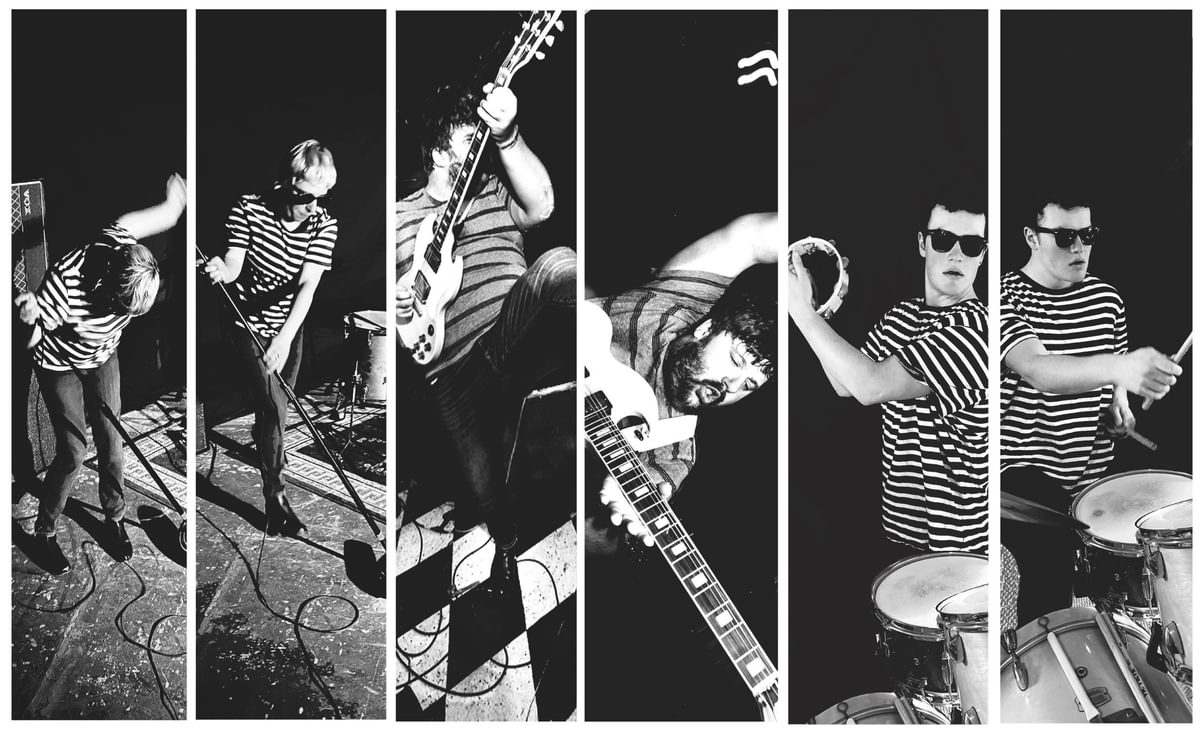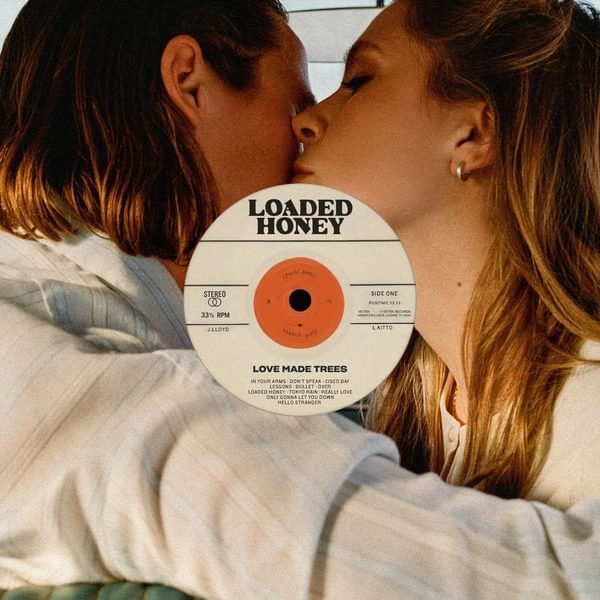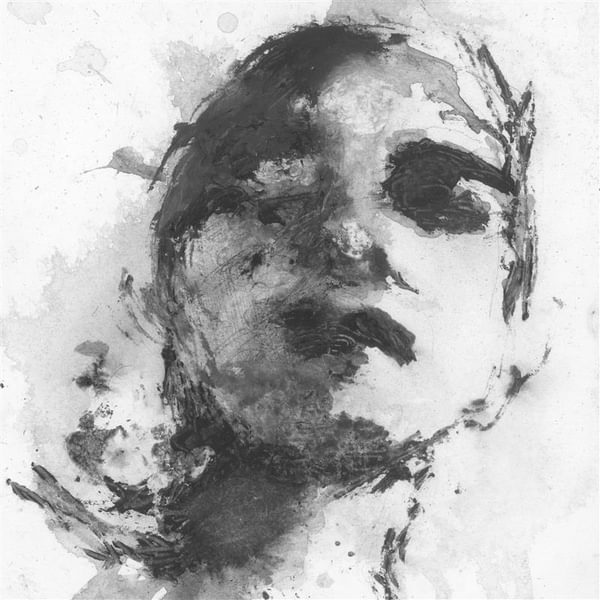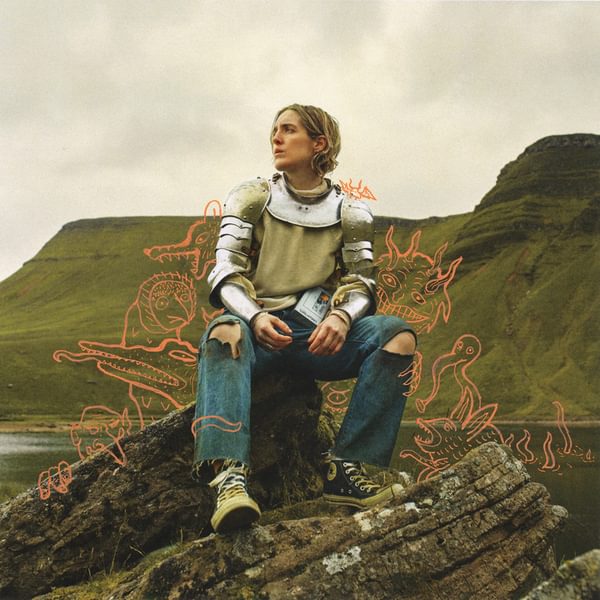
Perennial reflects on the history of Art History
Cut-and-pasting the best ideas from their DVD and record collections, Connecticut band Perennial have perfected their encyclopaedic art punk, writes Taylor Ruckle.
The tangle of cables had to be just right.
To shoot the cover for their third LP, 2024’s Art History, Perennial spent an entire afternoon sculpting their equipment – guitars, tambourines, pedals, and power strips – into a perfect heap on the floor of their basement while their cat Wasabi sniffed at the installation. After adding, subtracting, and taking alternate shots, they landed on an image that captured the chaos and cool of the album: all the sound-making implements draped like ivy over a monolithic stack of Fender amplifiers while co-lead vocalist and organ player Chelsey Hahn looks away, caught in the middle of an Elvis Costello-esque mic stand lean.
“It was fun to put together, just to pile everything up, and that’s sort of similar to how we write,” Hahn tells me. “Sometimes we just throw all the ideas and see what sticks.”
“If you’re trying to figure out what you wanna make for dinner, you look at what you have in the cupboards and in the refrigerator,” says guitarist and other co-lead vocalist Chad Jewett. “Here’s us gathering our materials.”
On Art History, the trio emerged from the kitchen with a towering Dagwood sandwich of sounds: two-minute punk songs, but with bluesy single-note riffs and organ whistles instead of straight power chords. Or, then again, maybe they’re ‘60s pop songs, but with cross-stage shouts instead of Lennon-McCartney harmonies. A year after the release, they’ve returned with a second helping in the form of “A” Is For Abstract: The Complete Art History. The deluxe reissue bundles the original album with the 2023 EP The Leaves of Autumn Symmetry, the 2024 EP Lemon on Plastic, two remixes, and the unreleased track “Baby, Are You Abstract?”. Arriving within a month of the band’s 10th anniversary, the compilation collects everything that went into making Art History the definitive record of the band’s signature style at the intersection of proto- and post-hardcore.
“More than any of our previous records, we were really pouring in all the stuff we liked sonically over decades and decades of records,” says Jewett. “Really saying, ‘Alright, our approach is still going to be this really minimalist art punk style, but let’s explore psychedelia, and R&B, and Stax soul, and Mod, and free jazz, and electronica, and all the stuff that we like… let’s see if we can do it in 21 minutes in the Perennial style.”
Though it took years to accomplish, that ambition was baked into Perennial from the earliest sketches. Hahn and Jewett previously worked together in bedroom pop band Lion Cub, but after releasing two albums on Topshelf Records, that project petered out; spiritually, something was missing, especially from their live show. In 2015, when they were in their late 20s, the two regrouped with drummer Wil Mulhern (who Jewett had played with in Aeroplane, 1929) and started cutting and pasting new ideas from their record and DVD collections: the intensity of Dischord Records punk, the visual flair of the British mods, Greek mythology, camp horror, and the classic pop stylings of Otis Redding (note the “have mercy on me” refrain on Art History’s second track, “Tambourine and Snare”).

“We wanted to make a band that we would still want to be in 30 years later,” says Jewett. “We had sort of learned from Lion Cub, ‘Alright, let’s make sure we’re making something that can fit all the stuff that we’re obsessed with.’”
The trio paid tribute to those early days on the Leaves of Autumn Symmetry EP, reimagining songs from their 2017 debut album The Symmetry of Autumn Leaves for a new era with the help of go-to producer Chris Teti. The concept for Art History started to develop soon after, as documented on the Lemon on Plastic EP. Along with the album’s future title track, it included three instrumental studies – “Impressionism”, “Minimalism”, and “Expressionism” – channeling the band’s love of ambient music. Jewett says they saw the encyclopedic theme as a metaphor for the all-encompassing pile of influences behind the album, and as a tongue-in-cheek boast.
“I think we all got a kick out of the playful brashness of calling an album Art History. You know, we’re already calling our own shot, like, ‘Here’s a classic.’”
“Action Painting” addresses the concept most directly, turning Jackson Pollock splatter-making into an instructional dance (the only instruction? Dance). But the Art History title also lends an extra layer of potential meaning to all of Perennial’s fragmented, impressionistic lyrics. When Hahn shouts, “We rip it up and then we start again” on “Tambourine on Snare”, it evokes both the Orange Juice lyric that titled Simon Reynolds’ famous history of post-punk and Claude Monet’s tendency to slash his canvases.
More than that, it references Perennial’s closest link to visual art (besides Jewett’s work designing all the merch). Though nobody involved in the Art History sessions had a degree in the discipline, Hahn spends her free time, especially on tour between load-ins and set times, making collages (you can see her work on a dedicated Instagram). A few years ago, she contributed a piece based on the Perennial song “Lauren Bacall in Blue” to a Special Agent Collage Collective zine full of music-inspired collages. As the band planned last year’s Art History release show at Arts Center East in Vernon, Connecticut, she hatched a last-minute idea to glue her two artistic passions into one body of work.
“I made a collage for each song the week before, which was really stressful,” Hahn says, laughing. “I would just listen to one song, like, five times in a row and then silently collage. I was thinking about decorating or somehow making the space we were playing in special, and since the release show was at an art center that had gallery capability, it just made sense.”
Over the last ten years, paying homage to the culture they love has brought Perennial closer to the people who make it. “A” Is For Abstract features remixes of Art History songs by Cody Votolato of the Blood Brothers (Jewett’s number one guitar inspiration) and Chris Walla (whose influence as a producer shows in the band’s dedication to hi-fi headphone-friendly mixes). In a decade of writing, recording, touring, and DIYing, the members of Perennial have remade themselves in the image of their musical ideals, and true to their band name, they have no intention of stopping here. After the recording of Art History, Mulhern retired from full-time membership with the band, though he still fills in for the occasional local gig. Jewett and Hahn have continued on with new drummer Ceej Dioguardi – they have a fourth LP slated for recording this summer.
“I really do believe in, if you’re an artist, making your life a work of art,” says Jewett. “For the last ten years since we started this project that has taken over our lives, if I’m listening to a record, at least 10% of what I’m doing is absorbing stuff that I might use for Perennial. If I’m watching a movie and there’s a cool shot with an interesting angle, I could think to myself, ‘Alright, there’s a flyer idea.’ It puts everything in a framework that I at least find really rewarding.”

After my chat with Jewett and Hahn, Perennial performs at DC9 in Washington, D.C. as part of the Liberation Weekend festival benefiting Gender Liberation Movement, a grassroots direct action collective for trans rights. During the show, Dioguardi is (by necessity) the only member of the band who keeps both feet grounded at all times; Hahn and Jewett always have at least one in the air or on a monitor. During “Up-Tight”, Jewett leaves the stage entirely to join the audience for about 100 iterations of the call-and-response chorus before coming back to swing the microphone around by its cable like a millennial Roger Daltrey.
In moments like that, there is no history but Art History. Maybe the members of Perennial were never technically born; maybe they emerged fully-formed in matching striped shirts from that stack of amps in a basement in the Connecticut suburbs one day. Maybe they see it that way themselves.
“We did a lot in ten years, but it also feels like Perennial’s always been around,” says Hahn. “My only regret is not being able to watch us as an audience member.”
Get the Best Fit take on the week in music direct to your inbox every Friday

Loaded Honey
Love Made Trees

Pulp
More

Lucy Gooch
Desert Window





